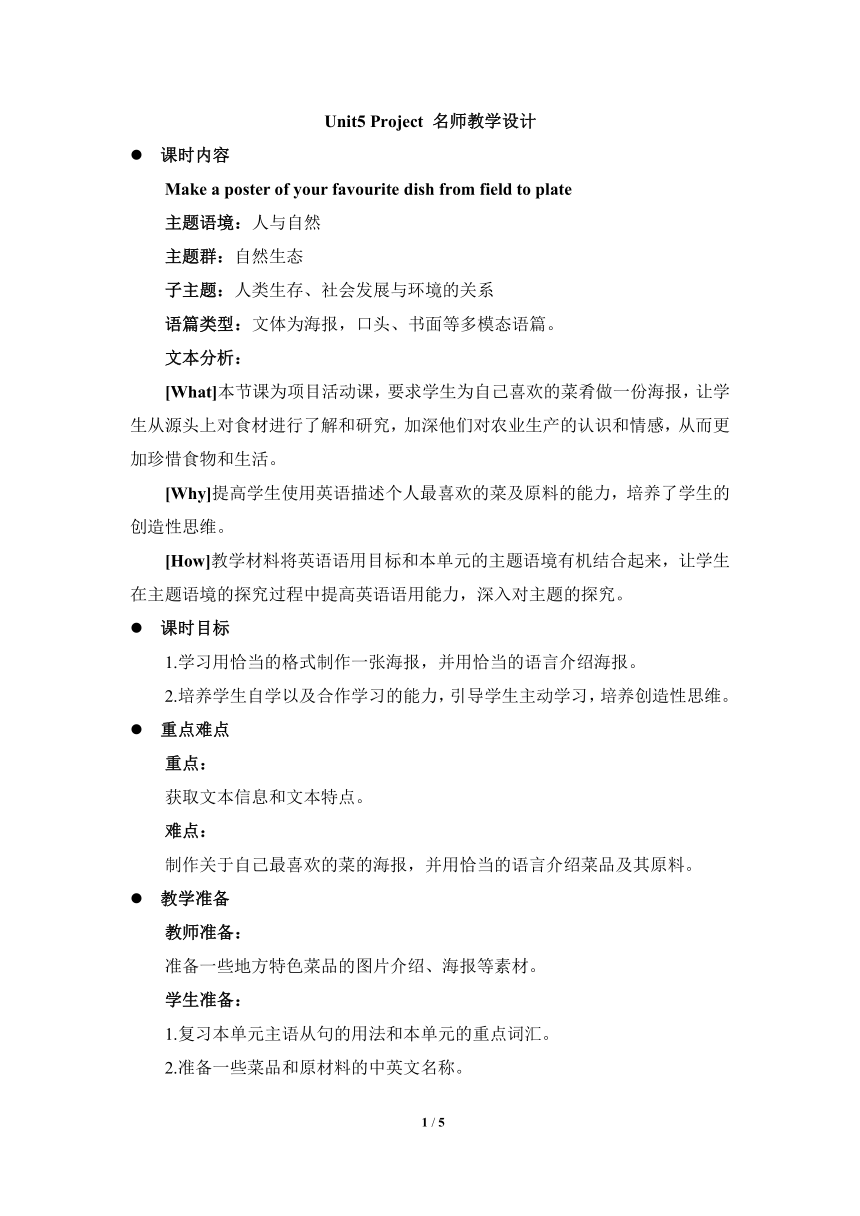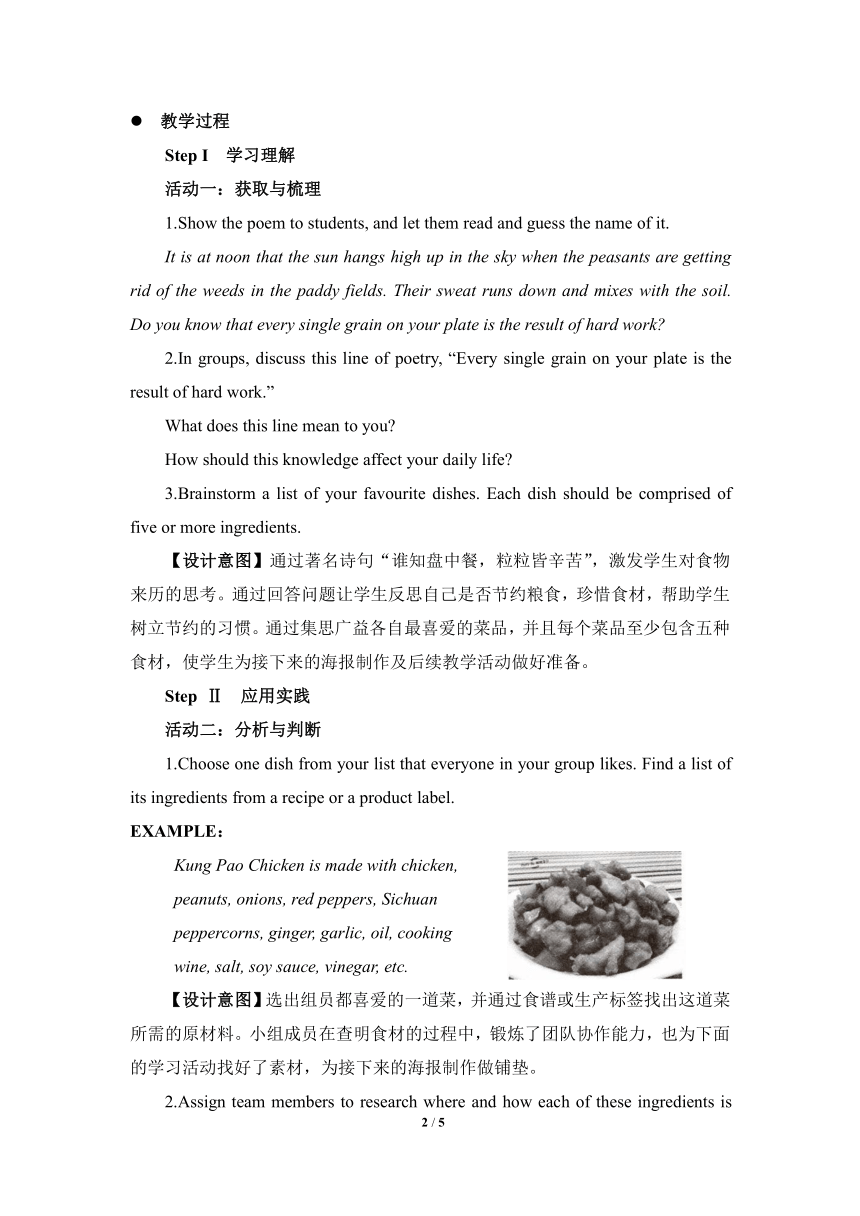人教版(2019)选择性必修 第一册Unit 5 Working the Land Project名师教学设计
文档属性
| 名称 | 人教版(2019)选择性必修 第一册Unit 5 Working the Land Project名师教学设计 |

|
|
| 格式 | docx | ||
| 文件大小 | 604.2KB | ||
| 资源类型 | 教案 | ||
| 版本资源 | 人教版(2019) | ||
| 科目 | 英语 | ||
| 更新时间 | 2023-03-12 07:01:59 | ||
图片预览


文档简介
Unit5 Project 名师教学设计
课时内容
Make a poster of your favourite dish from field to plate
主题语境:人与自然
主题群:自然生态
子主题:人类生存、社会发展与环境的关系
语篇类型:文体为海报,口头、书面等多模态语篇。
文本分析:
[What]本节课为项目活动课,要求学生为自己喜欢的菜肴做一份海报,让学生从源头上对食材进行了解和研究,加深他们对农业生产的认识和情感,从而更加珍惜食物和生活。
[Why]提高学生使用英语描述个人最喜欢的菜及原料的能力,培养了学生的创造性思维。
[How]教学材料将英语语用目标和本单元的主题语境有机结合起来,让学生在主题语境的探究过程中提高英语语用能力,深入对主题的探究。
课时目标
1.学习用恰当的格式制作一张海报,并用恰当的语言介绍海报。
2.培养学生自学以及合作学习的能力,引导学生主动学习,培养创造性思维。
重点难点
重点:
获取文本信息和文本特点。
难点:
制作关于自己最喜欢的菜的海报,并用恰当的语言介绍菜品及其原料。
教学准备
教师准备:
准备一些地方特色菜品的图片介绍、海报等素材。
学生准备:
1.复习本单元主语从句的用法和本单元的重点词汇。
2.准备一些菜品和原材料的中英文名称。
教学过程
Step I 学习理解
活动一:获取与梳理
1.Show the poem to students, and let them read and guess the name of it.
It is at noon that the sun hangs high up in the sky when the peasants are getting rid of the weeds in the paddy fields. Their sweat runs down and mixes with the soil. Do you know that every single grain on your plate is the result of hard work
2.In groups, discuss this line of poetry, “Every single grain on your plate is the result of hard work.”
What does this line mean to you
How should this knowledge affect your daily life
3.Brainstorm a list of your favourite dishes. Each dish should be comprised of five or more ingredients.
【设计意图】通过著名诗句“谁知盘中餐,粒粒皆辛苦”,激发学生对食物来历的思考。通过回答问题让学生反思自己是否节约粮食,珍惜食材,帮助学生树立节约的习惯。通过集思广益各自最喜爱的菜品,并且每个菜品至少包含五种食材,使学生为接下来的海报制作及后续教学活动做好准备。
Step Ⅱ 应用实践
活动二:分析与判断
1.Choose one dish from your list that everyone in your group likes. Find a list of its ingredients from a recipe or a product label.
EXAMPLE:
Kung Pao Chicken is made with chicken, peanuts, onions, red peppers, Sichuan peppercorns, ginger, garlic, oil, cooking wine, salt, soy sauce, vinegar, etc.
【设计意图】选出组员都喜爱的一道菜,并通过食谱或生产标签找出这道菜所需的原材料。小组成员在查明食材的过程中,锻炼了团队协作能力,也为下面的学习活动找好了素材,为接下来的海报制作做铺垫。
2.Assign team members to research where and how each of these ingredients is produced.
EXAMPLE:
Peanuts are planted in April or May. It takes around 120 to 160 days for them to be ready for harvesting. This is usually done by hand. The farmer pulls the peanut plants out of the ground and leaves them in the field to dry. The peanuts are then collected and separated from their vines. They are dried for some more time and then taken to the market for sale.
【设计意图】在学生制作海报之前,教师指导学生认真研究例子中的内容、图片等,为学生制作海报提供参考。
活动三:内化与运用
1.Work together to make a poster about your favourite dish. Each team member should explain where at least one ingredient comes from and how it is produced. Assign team members to prepare as follows:
·a large and colourful picture of the dish that everyone in the group likes.
·each team member has a report about where one ingredient comes from and how it is produced some small pictures of the ingredients of the dish a short introduction to the dish
2.Put the introduction,reports,and pictures together to make a poster about your favourite dish.
【设计意图】安排小组成员准备海报的素材,包括对小组成员都喜爱的菜的简短介绍、精美的图片和小组每位成员对菜的原材料的介绍。通过小组合作,不仅节约制作海报的时间,还培养学生的小组合作能力和团队精神。
Step Ⅲ 迁移创新
活动四:批判与评价
1.Take turns presenting your group's poster to the class,and give an introduction to your group's favourite dish. Then vote on the most interesting poster.
2.Review each group's poster according to the checklist:
·Is there a large and colourful picture of the dish that everyone in the group likes?
·Are there small pictures of the ingredients of the dish?
·Does each one of the group have a report about where the ingredient comes from and how it is produced?
·Is the short introduction to the dish clear?
·What can you learn from the poster?
【设计意图】该环节让学生以小组合作的方式对各个小组的海报作品进行批判性的评价,加深对主题意义的理解和多元思维的培养,有利于实现深度学习。
板书设计
Unit 5 Working the Land Period Ⅶ Project I.学习理解 活动一:获取与梳理 Ⅱ.应用实践 活动二:分析与判断 活动三:内化与运用 Ⅲ.迁移创新 活动四:批判与评价
2 / 2
课时内容
Make a poster of your favourite dish from field to plate
主题语境:人与自然
主题群:自然生态
子主题:人类生存、社会发展与环境的关系
语篇类型:文体为海报,口头、书面等多模态语篇。
文本分析:
[What]本节课为项目活动课,要求学生为自己喜欢的菜肴做一份海报,让学生从源头上对食材进行了解和研究,加深他们对农业生产的认识和情感,从而更加珍惜食物和生活。
[Why]提高学生使用英语描述个人最喜欢的菜及原料的能力,培养了学生的创造性思维。
[How]教学材料将英语语用目标和本单元的主题语境有机结合起来,让学生在主题语境的探究过程中提高英语语用能力,深入对主题的探究。
课时目标
1.学习用恰当的格式制作一张海报,并用恰当的语言介绍海报。
2.培养学生自学以及合作学习的能力,引导学生主动学习,培养创造性思维。
重点难点
重点:
获取文本信息和文本特点。
难点:
制作关于自己最喜欢的菜的海报,并用恰当的语言介绍菜品及其原料。
教学准备
教师准备:
准备一些地方特色菜品的图片介绍、海报等素材。
学生准备:
1.复习本单元主语从句的用法和本单元的重点词汇。
2.准备一些菜品和原材料的中英文名称。
教学过程
Step I 学习理解
活动一:获取与梳理
1.Show the poem to students, and let them read and guess the name of it.
It is at noon that the sun hangs high up in the sky when the peasants are getting rid of the weeds in the paddy fields. Their sweat runs down and mixes with the soil. Do you know that every single grain on your plate is the result of hard work
2.In groups, discuss this line of poetry, “Every single grain on your plate is the result of hard work.”
What does this line mean to you
How should this knowledge affect your daily life
3.Brainstorm a list of your favourite dishes. Each dish should be comprised of five or more ingredients.
【设计意图】通过著名诗句“谁知盘中餐,粒粒皆辛苦”,激发学生对食物来历的思考。通过回答问题让学生反思自己是否节约粮食,珍惜食材,帮助学生树立节约的习惯。通过集思广益各自最喜爱的菜品,并且每个菜品至少包含五种食材,使学生为接下来的海报制作及后续教学活动做好准备。
Step Ⅱ 应用实践
活动二:分析与判断
1.Choose one dish from your list that everyone in your group likes. Find a list of its ingredients from a recipe or a product label.
EXAMPLE:
Kung Pao Chicken is made with chicken, peanuts, onions, red peppers, Sichuan peppercorns, ginger, garlic, oil, cooking wine, salt, soy sauce, vinegar, etc.
【设计意图】选出组员都喜爱的一道菜,并通过食谱或生产标签找出这道菜所需的原材料。小组成员在查明食材的过程中,锻炼了团队协作能力,也为下面的学习活动找好了素材,为接下来的海报制作做铺垫。
2.Assign team members to research where and how each of these ingredients is produced.
EXAMPLE:
Peanuts are planted in April or May. It takes around 120 to 160 days for them to be ready for harvesting. This is usually done by hand. The farmer pulls the peanut plants out of the ground and leaves them in the field to dry. The peanuts are then collected and separated from their vines. They are dried for some more time and then taken to the market for sale.
【设计意图】在学生制作海报之前,教师指导学生认真研究例子中的内容、图片等,为学生制作海报提供参考。
活动三:内化与运用
1.Work together to make a poster about your favourite dish. Each team member should explain where at least one ingredient comes from and how it is produced. Assign team members to prepare as follows:
·a large and colourful picture of the dish that everyone in the group likes.
·each team member has a report about where one ingredient comes from and how it is produced some small pictures of the ingredients of the dish a short introduction to the dish
2.Put the introduction,reports,and pictures together to make a poster about your favourite dish.
【设计意图】安排小组成员准备海报的素材,包括对小组成员都喜爱的菜的简短介绍、精美的图片和小组每位成员对菜的原材料的介绍。通过小组合作,不仅节约制作海报的时间,还培养学生的小组合作能力和团队精神。
Step Ⅲ 迁移创新
活动四:批判与评价
1.Take turns presenting your group's poster to the class,and give an introduction to your group's favourite dish. Then vote on the most interesting poster.
2.Review each group's poster according to the checklist:
·Is there a large and colourful picture of the dish that everyone in the group likes?
·Are there small pictures of the ingredients of the dish?
·Does each one of the group have a report about where the ingredient comes from and how it is produced?
·Is the short introduction to the dish clear?
·What can you learn from the poster?
【设计意图】该环节让学生以小组合作的方式对各个小组的海报作品进行批判性的评价,加深对主题意义的理解和多元思维的培养,有利于实现深度学习。
板书设计
Unit 5 Working the Land Period Ⅶ Project I.学习理解 活动一:获取与梳理 Ⅱ.应用实践 活动二:分析与判断 活动三:内化与运用 Ⅲ.迁移创新 活动四:批判与评价
2 / 2
